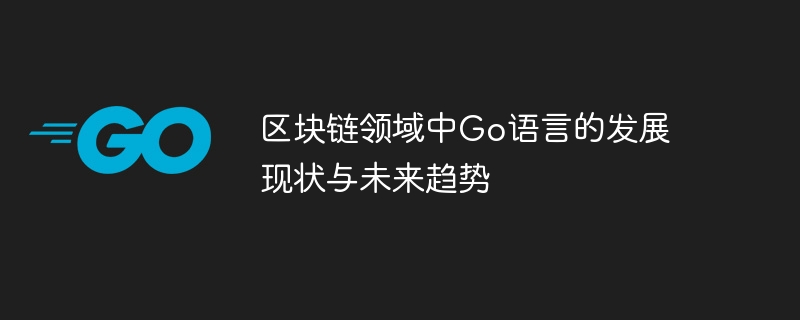Home >Backend Development >Golang >The development status and future trends of Go language in the blockchain field
The development status and future trends of Go language in the blockchain field
- WBOYWBOYWBOYWBOYWBOYWBOYWBOYWBOYWBOYWBOYWBOYWBOYWBOriginal
- 2024-03-11 10:09:04717browse

As one of the technology fields that have attracted much attention in recent years, blockchain technology has attracted the attention of many developers and researchers. Among them, Go language, as a programming language with superior performance, efficiency and reliability, has gradually been widely used in the blockchain field. This article will discuss the development status and future trends of Go language in the field of blockchain, and give specific code examples to demonstrate the application of Go language in blockchain development.
1. Current application status of Go language in the blockchain field
As a statically typed, compiled, and highly concurrency programming language, Go language has good performance and concise syntax. , very suitable for development in the blockchain field. Currently, in the field of blockchain, the Go language has been widely used, covering many aspects from the development of the underlying blockchain platform to the writing of smart contracts.
- Blockchain underlying development: Many well-known blockchain projects, such as Bitcoin, Ethereum, etc., use Go language for underlying development. The high-efficiency performance and excellent concurrent processing capabilities of the Go language enable the blockchain network to run faster and more stably.
- Smart contract writing: Smart contracts are programs on the blockchain that are used to execute various automated contracts and functions. The simplicity and readability of Go language make it easier for developers to write smart contracts and avoid some common mistakes.
- Blockchain application development: In addition to underlying development and smart contract writing, Go language is also widely used in the development of blockchain applications. Developers can use the rich libraries and powerful standard libraries of the Go language to quickly build blockchain applications and implement various functions.
2. The future trend of Go language in the blockchain field
With the continuous development of blockchain technology, Go language, as an efficient and easy-to-use programming language, It will have wider applications and a better future in the blockchain field. The following are some possible future trends:
- Improvement of the ecosystem: As more developers join the blockchain field, the ecosystem of the Go language will continue to improve, covering more fields. Tools and libraries make development more convenient.
- High-performance blockchain platform: The high performance and concurrent processing capabilities of the Go language will help develop a faster and more reliable blockchain platform and provide users with a better experience.
- Further development of smart contracts: The readability and simplicity of the Go language will help the further development of smart contracts, and developers can write complex smart contracts more easily.
3. Specific code examples
The following is a simple blockchain example, using Go language to implement a simple blockchain system:
package main
import (
"crypto/sha256"
"encoding/hex"
"fmt"
)
type Block struct {
Index int
Timestamp string
Data string
Hash string
PrevHash string
}
func calculateHash(block Block) string {
record := string(block.Index) + block.Timestamp + block.Data + block.PrevHash
h := sha256.New()
h.Write([]byte(record))
hashed := h.Sum(nil)
return hex.EncodeToString(hashed)
}
func generateBlock(oldBlock Block, data string) Block {
var newBlock Block
newBlock.Index = oldBlock.Index + 1
newBlock.Timestamp = "2022-01-01"
newBlock.Data = data
newBlock.PrevHash = oldBlock.Hash
newBlock.Hash = calculateHash(newBlock)
return newBlock
}
func main() {
genesisBlock := Block{0, "2021-01-01", "Genesis Block", "", ""}
chain := []Block{genesisBlock}
newBlockData := "Data for new block"
newBlock := generateBlock(chain[len(chain)-1], newBlockData)
chain = append(chain, newBlock)
fmt.Println("Blockchain:")
for _, block := range chain {
fmt.Printf("Index: %d
", block.Index)
fmt.Printf("Timestamp: %s
", block.Timestamp)
fmt.Printf("Data: %s
", block.Data)
fmt.Printf("Hash: %s
", block.Hash)
fmt.Printf("PrevHash: %s
", block.PrevHash)
fmt.Println()
}
}Above The sample code shows a simple blockchain system, including block structure, calculating hashes, generating new blocks and other functions. Developers can refer to this example to further understand how to use Go language to develop blockchain applications.
In general, the Go language has broad application prospects and development space in the blockchain field. With the continuous evolution of blockchain technology, the Go language will continue to play an important role in providing blockchain applications. development and innovation provide more possibilities.
The above is the detailed content of The development status and future trends of Go language in the blockchain field. For more information, please follow other related articles on the PHP Chinese website!
Related articles
See more- Study the underlying development principles of PHP: exception handling and error tracking technology
- Oracle announces extension of long-term support for Java 11 until 2032, with Java 21 leading future trends
- Future trends in cloud and generative artificial intelligence
- What are Ethereum and smart contracts?
- Summary of the latest meeting of Ethereum core developers: final progress of Dencun upgrade and discussion of Pectra upgrade scope

